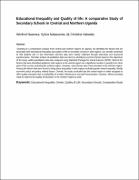| dc.description.abstract | Drawing on a comparative analysis from central and northern regions of Uganda, we identified the factors that are associated with educational inequality and quality of life in secondary schools in both regions. Our sample comprised of 358 students and 72 key informants, primary data were mainly collected through interviews and structured questionnaires. Thematic analysis of qualitative data was done by identifying common themes based on the objectives of the study, while quantitative data were analyzed using Statistical Package for Social Sciences (SPSS). Most of the factors that were identified applied to both regions as the central region has a significant number or people from other parts of the country including the northern region. However, some factors were more prevalent in the northern region. Among the factors that were found to bring about inequality in both regions included gender-based inequality, family economic status and policy related factors. Overall, the study concluded that the central region is better equipped to offer quality education due to availability of a better infrastructure and staff remuneration, however, efforts are being made to improve the quality of education in the northern region as well. | en_US |


